Revolt of the Social Intellectual
Revolt of the Social Intellectual: is the pen mightier than the sword?
By Sindhu Ravuri
Pictures Meena Yeggina
Just a day before Mahatma Gandhi’s birthday in the Uttar Pradesh village of Dadri, India, a 53-year-old village blacksmith, Mohammed Akhlaq, and his family are enjoying lazy, after-dinner time together. That’s when a mob of approximately 100 Hindus storm into their house.
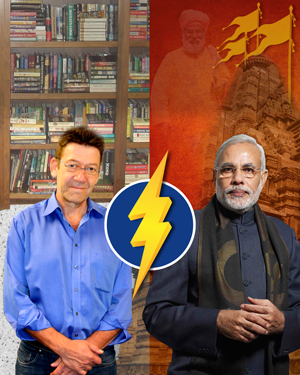
Just minutes earlier, two unidentified men had entered a local temple, forcing the priest to announce publicly that Akhlaq’s family slaughtered a cow. Communicating through WhatsApp , several young Hindu men joined around the temple in minutes to begin a march toward the unsuspecting family.
The unfamiliar men blacken Akhlaq’s mother’s eye, drag him and his 21-year-old son outside, bash Akhlaq’s head with a sewing machine and then lynch him to death. The only reasoning behind the assault was suspicion of cow slaughter, and therefore disrespect for Hindu worship of the sacred animal.
The two men who earlier approached the priest, both allegedly of the Bharatiya Janata Party (BJP) to which Prime Minister of India, Narendra Modi, belongs to, were arrested. Even before the nation could understand what happened, several top BJP leaders labeled the incident “accident, and “stray.” Ultimately, the beef for which Akhlaq was murdered turned out to be mutton.
The Dadri lynching evoked tremendous response throughout India. Vegetarians and nonvegetarians, minorities and majorities, men and women alike reacted with shock, empathy, and thirst for justice; more importantly, people were stunned at the unprecedented and targeted terror directed toward an innocent man simply based on the rumor of eating beef. Major political leaders, like Aam Aadmi Party (AAP) representative Arvind Kejriwal, traveled to the village to express their condolences.
Considering India’s massive population of over one billion, intolerance toward another community is not a new, or rare, phenomenon. Historically, cases of intolerance like the 1984 Sikh riots, were overtly condemned, criticized and addressed through the removal of irresponsible authorities. Now, however, according to critics, hate crimes against minorities are being increasingly overlooked with a convenient turn of the head by the government itself.
According to Thomas Blom Hansen, Director of the Stanford University Center for South Asia, Modi’s decisions to ignore hate crimes against minorities stems from his inculcated alliance with the Rashtriya Swayamsevak Sangh (RSS) ideology. That underlying RSS philosophy also bleeds into Modi’s political decision to promote an anti-secular India controlled by Hinduism and Hindutva. (See full interview on Pg.58)
Modi’s ideological choices have not only sparked national outrage over the genesis of India as a virulent, polarized society rooted in prejudice, but also brought international attention: recently, just before Modi’s visit to the United States, academics from various prestigious universities signed a petition. The petition reminded Silicon Valley technology enterprises of their corporate responsibilities when conducting business with a government, like the BJP, that has already demonstrated its disregard for human rights, civil liberties, and educational or cultural autonomy.
Far away in the Indian subcontinent, a stronger yet similar rebellion began brewing, and within a month it became an inextinguishable, nonviolent ideological war for justice.
The Unprecedented Revolt of the Indian Writers
It is a calm Sunday morning, and 77-year-old writer and rationalist Malleshappa Madivalappa Kalburgi is drinking a cup of coffee in his house in Karnataka, South India. His wife, Umadevi, opens the front door and invites the man who rang the bell. The man, who had arrived on a motorcycle, was posing as a student, while another man waited near the bike. Umadevi makes her way to the kitchen to bring coffee, when two shots fire behind her. The men had shot her husband dead. And before she can react, the criminals flee.
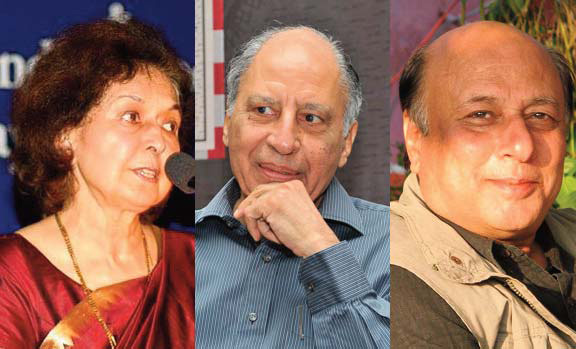
Picture courtesy Scroll.in
The reason behind Kalburgi’s, a Sahitya Akademy award recipient, murder was a June 2014 seminar in Bangalore on the anti-superstition Bill. During the seminar, Kalburgi detailed UR Ananthamurthy's 1996 book “Bethale Puje Yake Kudadu,” or ”Why nude-worship is wrong.” The book’s author described his childhood experience of urinating on Hindu idols as an experiment to see whether there would be divine retribution, inciting intense protests from Vishva Hindu Parishad (VHP), Bajrang Dal, and Sri Ram Sena - extremist Hindu, right-wing groups affiliated with Prime Minister Narendra Modi’s BJP and the RSS. This kind of reaction wasn’t new for Kalburgi - earlier his work also challenged the Lingayat community, one that worships Lord Shiva. But, this time, the dissenting groups threatened to kill him. And they did. So far, only one man of the Sansthan Sabha, a right wing Hindu organization, has been arrested on suspicion.
Kalburgi was the last amongst three renowned writers to be recently murdered for their controversial, Hinduism- questioning work. In all three cases, the killers are suspected to be Hindutva supporters. No arrests were made so far.
Nayantara Sahgal, renowned writer and niece of first Indian Prime Minister Jawaharlal Nehru, outraged by the murders of Kalburgi, Narendra Dabholkar and Govind Pansare, said that rationalists who question the intellectual or artistic interpretations of Hindutva – whether it be lifestyle or clothing – are being marginalized, persecuted, or murdered.
Sahgal returned her 1986 Sahitya Akademi award on October 6, following the aforementioned murders and the Dadri lynching, what she refers to as the “last straw,” in protest against the Modi government's "failure to protect cultural diversity." Sahgal, who won the award for her novel “Rich like Us,” a historical and political fiction, in the process kick- started a trend motivating several other writers, in anguish over the persecution of Muslim minorities, to return their awards.
The Sahitya Akademi Award is provided by India's National Academy of Letters and The Central Institution for Literary Dialogue, Publication and Promotion. Every year since its inception in 1954, the Sahitya Akademi Award prizes to the most outstanding books of literary merit published in any of the major Indian languages, according to the official Sahitya Akademi website. Past recipients have come from different states, speak in different languages, and write about different subjects ranging from love and death to history and government. The award also carries about $1600 in cash prize.
41 authors from the states of Jammu & Kashmir and Punjab in the North, Assam in the East, Gujarat and Maharashtr in the West, and Kerala and Karnataka in the South have an nounced that they will be returning their Sahitya Akademi awards, or have stepped down from official positions in the organization. The writers were also upset with the Akademy’s silence on the murder of fellow recipient and ac ademic Kulburgi. Additionally, 53 historians, 12 filmmakers, 400 artists, 134 scientists (including a Padma Bhushan), and 75 sociologists either returned their awards or proclaimed support through written statements.
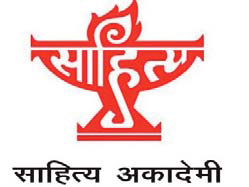 The Sahitya Akademy, on Oct. 23, issued a statement condemning all attacks on writers, thus lending great support to the Award Wapsi (“Return the Award”) movement. Now, founder of Infosys NR Narayana Murthy and Nobel laureate Kailash Satyarthi have also joined the cause and pledged their support.
The Sahitya Akademy, on Oct. 23, issued a statement condemning all attacks on writers, thus lending great support to the Award Wapsi (“Return the Award”) movement. Now, founder of Infosys NR Narayana Murthy and Nobel laureate Kailash Satyarthi have also joined the cause and pledged their support.
The writer’s revolt shook the upper echelons of Indian society, who had never seen such a silent, peaceful and simultaneously strong revolutionary statement. Similarly, the BJP government reacted to the unanticipated protest quickly yet dismissively. While the Union Culture Minister Mahesh Sharma said it was “nothing” unless the writers actually “stopped writing,” other political figures doubted the writer's’ intentions and ideologies, labeling the them as “communist” cadres and with a “manufactured” agenda against Modi.
In a lengthy post on Facebook, Modi’s finance minister Arun Jaitley ridiculed the protests as political sour grapes by leftist writers still reeling from “the shrinking fortunes” of their traditional government patrons, the Indian National Congress and the Nehru-Gandhi dynasty. Instead of allaying the clear anxiety of the civilians, BJP leaders began chipping away at the character of the renowned writers. Indeed, investigative officers from the central government visited one of the writers’ house in Gujarat and inquired about his political leanings, and his opinions toward the ruling government.
Professor Emerita of Jawaharlal Nehru University (JNU) and one of India’s foremost historians, Romila Thaper, says that the opinion of a public intellectual is crucial since it is well-informed and based on reason. In other words, the revolt of intellectuals is founded on evidence and rationale rather than flawed bias or emotion. Further, Thaper says that public intellectuals are very concerned about safeguarding human rights and social justice. Hence, it would be most beneficial for India if the government does speak to them rather than dismissing their every word.
The writer’s revolt shook the upper echelons of Indian society, who had never seen such a silent, peaceful and simultaneously strong revolutionary statement
The Real Beginning
The protest against Modi did have a prominent base through the writers revolt. Nevertheless, its conception happened here in the United States, when anger against Modi’s tactics bled into the collegiate educational domain. This past August, upon the imminent arrival of Modi to the United States, more than 125 academics signed a petition advocating their concern over human rights violations under Modi’s rule. Academics from Stanford, UC Berkeley, and Princeton, to name a few, signed the petition. It was only after this initiative that the Award Wapsi movement came about in India.
“The reasons [for the protest] are two-fold,” said Richard Falk, Professor of International Law Emeritus, Princeton University, who is one of the signatories. “It is definitely a combination of the issues raised by Digital India (an initiative by the Government of India to ensure that Government services are made available to citizens electronically by improving online infrastructure and by increasing Internet connectivity. It was launched on July 1, 2015 by Prime Minister Narendra Modi), in interaction with concerns associated with the specific nature of Narendra Modi’s background as a Hindu nationalist leader and his approach and that of the BJP to political leadership.” (See full interview on Pg. 42)
The open letter was published on the The Academe Blog, an academic website run by the American Association of University Professors. The petition also expressed concerns about freedom and privacy of the people under Modi, who has a record of “intolerance, violence and fascist rule.”
Those who signed the petition anticipated well-informed debate, conversation and educated opinion regarding their stance. Instead, they were “threatened, warned of consequences for being anti-Hindu and anti-India” and asked to “withdraw signatures.” According to Hansen, the threats also said failure to do so would result in the professor's “repenting with untold suffering on [their] deathbed[s].” (see full interview with Professor Hansen on Pg 58)
Despite the violent warnings, not a single signatory wavered. They knew their arguments in the petition were rooted in history, fact and research. So, they had nothing to be afraid of.
The murders of rationalists, harassment of whistleblowers like Teesta Setalvad and Sanjiv Bhatt in the 2002 Gujarat riots case allegedly involving Modi, denial of justice to victims of religious pogroms and caste-based massacres, emboldening of the religio-lunatic fringe and the impunity of those who kill or advocate killing in the name of religion upset the protesters tremendously. Furthermore, the accompanying rewriting of history by certain religious groups and denial of scientific enquiry deeply worried the intellectuals.
Currently, Modi is preparing for a visit to Britain in November. Just as in the U.S., several feminist organizations and academics in Britain, wrote a concerned letter regarding Modi’s silence over the murders of minorities and rationalists, his association with RSS - which they think is a "paramilitary organization modeled on the Italian Fascist and German Nazi parties known for its violent misogyny openly displayed in the pronouncements of its leaders” - and his tacit approval of hate crimes targeting minorities.
Facebook HQ, San Jose, CA September 27
Donning a pitch black vest, slacks, and button-up white shirt, Modi sits adjacent to Facebook co-founder Mark Zuckerberg, in matching black and white, to talk about Digital India. The moment marks the first time in three decades an Indian prime Minister has set foot on Bay Area soil. A large, mostly Indian-American, crowd of Facebook employees, their relatives, and friends sits in the audience.
After two pre-screened questions and audience enquiries, Zuckerberg gradually approaches his final question, asking Modi what family means to him. Modi, in turn, starts explaining how his mother washed dishes to support him growing up, and suddenly pauses. His tone becomes heavy, eyes moist. Many audience members gasp, stunned at the Prime Minister’s raw emotion.
“I felt he was one of us,” one young woman said to NDTV directly following the question-and-answer session. “He seemed so moved.”
As Shah Rukh Khan’s song “Chak De” blares in the background, Modi, with Zuckerberg in tow, walks out triumphantly, escorted by the audience’s roaring chant of his name.
13,568 kilometers away in India, though, few are impressed with Modi.
His supporters, familiar with his background, remain politely silent, while his opponents openly mock his tears. Political activist, columnist and member of the Aam Aadmi Party, Ashutosh (dissociated from his last name to separate his caste from politics) even tweeted, “What an actor? Oscar winning performance!!!!” in response to Modi’s emotional oration. He continues, “I wish he had cried for those who were killed in 2002 riots!!!” referring to Modi’s alleged involvement in the said riot’s murder of 2000 Muslims. Still others, like Mani Shanker Iyer, the leading opposition party’s spokesperson, declared Modi a liar on national television, saying “He never sold chai (tea). He only helped in his father’s canteen. [His family was] not [so] poor that his mother washed dishes to bring him up.”
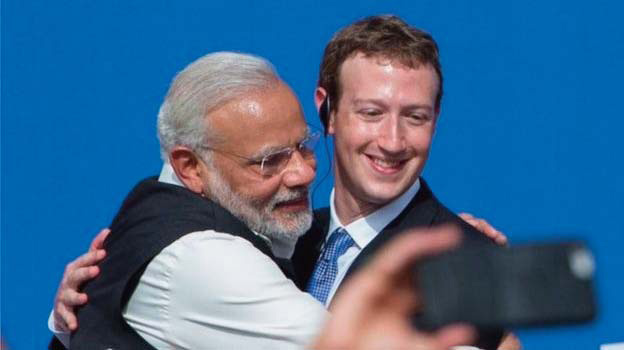
One of a Kind?
Picture by Getty Images
Regardless, Modi already established his own personal NRI fan base, one he expanded by delivering another passionate speech to about 18,000 people at the San Jose SAP center the evening of his Q & A with Zuckerberg. He spoke passionately about Digital India, corruption in opposition parties, and the greatness of non-resident Indians in the Bay Area.
“His speech was vague, yet saturated in passionate rhetoric; it was a mix of truth and hype lacking precise details,” said Sujata Desai. “I loved it though, and couldn’t help clapping for him.” She called him a “Rockstar!”
On October 4, Indian journalist and columnist Aakar Patel, writing in the Outlook Magazine, described the Rockstar phenomenon, explaining the large Modi fan following in the United States. According to him, “the frenzied fan base of rockstars essentially arises from their charisma, not their humanity or their higher mental faculties. Rather, a perception of heroism, decent public image, and decent appearance fosters a cosmetic and superficial love from others, perhaps not completely needed or desired for a serious statesman.”
“I just want to welcome him with love and affection,” said Raj Bhanot, founder of the Sunnyvale Hindu Temple, Sunnyvale. “And I would do that to any prime minister. When Manmohan Singhji came, he did not invite us. But Modi ji did. And we are happy. He is a hard worker. He works 18 hours a day and he wants to bring development to India. Any prime minister who wants to do good for India, I am fine with him.”
Disjointing Secularity and Democracy
Modi’s Silicon Valley
When handful of local Hindu groups at the SAP center adorning saffron-colored attire were asked why they chose that specific color, one member exclaimed that she wanted to reflect the colors of the Indian flag. Instead of embodying all three colors of the Indian flag, orange, green and white, though, these individuals only chose to represent one facet of the country.
The orange, green, and white collectively symbolize the union of Hinduism, Islam and Christianity - thus the democratic and secular fabric of India. In choosing to only align with Hinduism, these groups were sending a resonant message that innately excluded roughly 176 million who identified as Muslim in India (according to a 2013 report by the Pew Research Center), said Rashid (not his real name) at the SAP center.
The idea of pleasing Modi through overwhelming manifestations of Hindu propaganda did not restrict itself to common people. Even Zuckerberg actually told Modi during the Q & A that he went to a Hindu temple in India to clear his thoughts. Furthermore, at the SAP center, an Indian-American Congresswoman was introduced to the crowd as the “first Hindu Congresswoman.”
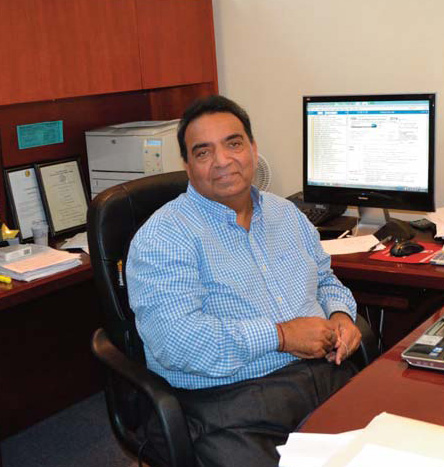
Raj Bhanot, Founder, Sunnyvale Hindu Temple
Picture by IndiaParentMagazine
These actions, though small, illustrate a larger movement the BJP is gradually clawing toward and hoping for - that of a religion-dominated, autocratic Hindu rule over India and Global Hindu support for the same, according to Hansen.
“The danger with the BJP is that this Hindu majoritarian ethos is being brought forward that says, ‘we don’t have to explain why we want to promote Hinduization of educational programs, history teaching, or public symbols. Democracy is majority rule, so since we have the majority as Hindus we can do whatever we want,’’” Hansen said. “That’s scary. I still have confidence in what is the most infuriating aspect of India from the government’s point of view – that everything the government tries to do is always met by opposition; there is always someone who is unhappy, someone who is protesting. But this also is the redeeming part of India – this is what keeps democracy growing and creates a real space of freedom for people. BJP fundamentally doesn’t accept these kind of political and cultural freedoms as matter of cause. They are actually totally set against it, and their whole history as a movement is about containing those freedoms.”
Since it inception, the BJP has been symbolically trying to “remove the word ‘secular’ from the Indian subconscious as [its] first step to change the nation into a Hindu rashtra [nation],” says Chandan Sharma (not his real name), a software engineer, who wanted to remain anonymous out of fear of backlash. “This change is doing nothing to address real problems like removing the British proposed law 377 which makes LGBT (Lesbian, gay, bisexual, transexual) rights illegal in India.”
 Several groups of Sikhs, Muslims, female rights and LGBT activists who were protesting against Modi outside of the SAP center in San Jose were threatened and pushed around by Modi supporters.
Several groups of Sikhs, Muslims, female rights and LGBT activists who were protesting against Modi outside of the SAP center in San Jose were threatened and pushed around by Modi supporters.Picture by IndiaParentMagazine
“Modi’s visit to us is a digression, a fun evening out” he continued. “Like Shah Rukh Khan’s visit, Modi’s visit is also viewed as an evening’s entertainment. And he doesn’t disappoint. His speeches are energizing, funny and provocative. But just as in fast, upbeat song, the entertainment doesn’t last. Most of us are busy in our lives and we are just happy that our prime minister is coming to see us. That’s it. To most of the young here it does not go beyond that. What’s happening in India doesn’t really matter. However it highly saddens me that while enjoying the fruits of freedom and the laws of inclusion that are helping us stay happy here, we are completely ignoring the rights of others like say LGBT individuals or other minorities, and what is happening to them in India under certain political parties. Moreover, we are failing to consider what repercussions it might have on us immigrants here.”
Since no legal boundaries are established against such crimes, religious and social disparity as well as brutality against minorities is still accepted, sometimes encouraged. Several groups of Sikhs, Muslims, female rights and LGBT activists were protesting against Modi outside of the SAP center in San Jose were insulted, threatened and pushed around by Modi supporters.
"All I, being the chairperson of Trikone, did was to peacefully take a stand on the public grounds of the city of San Jose holding the sign -’377,’” Mohammed Shaik Hussain Ali, chairman of U.S.-based gay rights organization Trikone said in an interview with Firstpost. “The old British law still haunts Bangladesh, Pakistan, India, Maldives, Myanmar and more...I was attacked. My fellow comrades holding equally neutral messages were attacked. My sign was snatched, broken and thrown. I was dragged, pulled out by my collar, held on my neck and was yelled at - 'you don't belong here'. The attackers were my fellow Indians. The attackers asserted their Indian majority status...Collecting myself off today's moments, I am left with a haunting question - if the Indian majority, the 'educated' lot, standing on non-Indian ground, can resort to such means to drive their point across, what is the plight of the LGBT minorities on Indian soil?’"
Who is Narendra Modi?
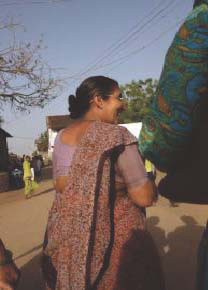
Modi’s wife to this day awaits his return.
Picture courtesy Mid-day
On Diwali of 1958, an eight-year-old Narendra Modi, eager to do something more than pursuing his education, took the oath of becoming an official child volunteer of Bal Swayamsevak, a youth wing of RSS.
Born to Damodardas Mulchand Modi and his wife, Heeraben, Modi was the third amongst six children. The family belonged to the Ghanchi caste of Gujarat, ran a tea shop at Vadnagar railway station, and operated an oil mill. According to his teacher at Bhagavatacharya Narayanacharya High School, Modi was keen to pursue debate and theatre, but was an average student in core academic courses, as reported in the Caravan Magazine on March 2012. Adhering to the traditions of his caste, his parents arranged his marriage in Vadnagar approximately at the age of three, with the actual matrimonial ceremony ( shaadi ) at the age of 13. But at age 18, Modi set off to the Himalayas, leaving his wife and two families behind in uncertainty. He believed that a higher call beckoned him, according to the Caravan magazine. A few years later, he returned to his hometown to reconnect with RSS.
Modi’s critics unequivocally targeted him for being a bad son and an abandoning husband. He is too remote and not a family man, according to a Congress spokesperson. While his mother has dissociated herself (she chose not attend his swearing in ceremony as the Prime Minister) to a certain degree, Modi’s wife to this day awaits his return. Her existence came into public view only after Modi acknowledged his marital status during the 2014 electoral declaration. A teacher in a small village, she thinks that Modi is too “handsome” to accept her, according to a report in Mid-day in 2014. Living in an unconsummated marriage of about 46 years, Modi’s wife lives in “fear and expectation [for] that one phone call from Modi inviting her to live with him,” because the Prime Minister ”never divorced her nor accepted her[,] except acknowledging his marital status for electoral reasons.”
Of all the relations Modi found sacred, his with the RSS was the one he truly dedicated his life and beliefs to. Since married people were not allowed to become pracharaks, a full-time worker dedicated to spreading the ideology of the RSS through personal contact, meetings, and public lectures. As a result, Modi joined the RSS without mentioning his marriage.
Hansen, who met him in 1990s, thought that Modi would never rise in political hierarchy. However, through his “shrewd tactical acumen and vigorous RSS training,” Modi ascended the RSS rank. His assiduous nature and ingenuity propelled him to the forefront of the movement. Legend has it that, when RSS had a large sum of money available at its disposal for a meeting but did not know how to safekeep it, Modi simply dug a hole, placed the cash in it and laid his bed over the hole, as reported in Caravan, 2012.
Thus Modi was the first RSS pracharak (proponent) to become chief minister. According to an article in Caravan by Vinod K. Jose, Modi, allegedly, eliminated, some physically and some figuratively, each of his political opponents and competitors during his rise to power in Gujarat (such as the powerful Keshubhai Patel, Sanjay Joshi, Haren Pandya and Gordhan Zadaphia).
The RSS Influence on Modi
According to Hansen it is impossible to segregate Modi from his RSS background. Modi spent more time with RSS than with his family and, as a result, has developed a fundamental political view mirroring theirs that influences his every decision.
“The RSS has a fundamentally anti-democratic instinct; it takes pride in being a non-democratic movement,” he said. “It has a self-supplying leadership, so you work your way through it – you’re never elected. It’s based on loyalty and discipline, and lack of debate. They yet have to understand functioning in a democratic circumstances meaning you have to accept critique, freedom of speech, freedom to dissent, the rule of law, and so on. These are fundamentals and I don’t see that instinct at all in RSS – the movement’s DNA is different.”
As a politician Modi learned early on how to raise hopes and build perceptions in the name of development, while still retaining his basic, almost monopolistic RSS-like power, Hansen says.
“I don’t see necessarily a politician who is saying something completely new,” Hansen said. “I see him as an RSS pracharak who has learned to do populist politics. I still think he’s an RSS man through and through, and I don’t think he’d deny that himself.”
Modi Irony: “Make in India” precedes Making India
Many agree that although Modi's Digital India (technological plan to propel India into a completely digital lifestyle) and “Make in India” (plan to establish branches of foreign companies in India) campaigns are quite promising, real change requires a different vision that is both culturally and economically inclusive.
According to various protest groups who were present at Modi’s speech in the SAP center, the Prime Minister’s dream of transforming India into a 21st century superpower with a $20-trillion economy can only actualize if he himself restrains bigoted ministers and fringe elements from the BJP. Also, he must expel affiliated organizations that encourage a divisive society. In his 16 month rule thus far, Modi has failed to fulfill these tasks. Instead, he has condoned several bans, invalid Internet laws and abrasive minority threats.
And therein lies the irony of Make in India, says founder of the Aam Aadmi Party Arvind Kejriwal.
"The [Prime Minister] should first focus on making India,” Kejriwal said in a series of tweets. “Going around the world pleading people to come to India will not help. The government should first spend on [the] people of India and the world [will] follow. If we create a conducive atmosphere, people will automatically come, invest and Make in India. ... Make India [means investing] in health, education, water, safety, justice and infrastructure.”
Richard Falk, Professor of International Law at Princeton University echoes Kejriwal’s sentiment, acknowledging that while the Digital India plan has great potential, its actual fruition is dubious.
“The concerns about Digital India are multiple, yet the program has not been sufficiently developed,” he said. “There is much positive potential bound up in Digital India that should not be overlooked. For instance, .... it gives emphasis to individual empowerment, which would, if implemented, strengthen the role of citizens, and contribute to more meaningful participation in the societal life of India.” Falk then addressed concerns about the marginalizing capacity of Digital India.
“There are also worries associated with whether Digital India will treat minorities equally with the Hindu majority, especially in the extension of digitization to minority communities,” Falk said. “A related concern is whether this drive to achieve 21st century style modernization will not widen disparities between those able to take advantage of Digital India and those who are not. These worries are best set forth at the outset. If postponed until the harm is done, it will be much more difficult to correct. There is also a worry that the state can use a highly networked India to exert greater control, damaging the state balance that is crucial for the maintenance of a robust democracy.”
The Make in India campaign in the Bay Area began to see cracks when Modi’s visit in September to Tesla, the electric car company in San Jose, proved somewhat futile. According to a report in Economic Times on Oct 25, Elon Musk revealed that he is planning to team with China to produce vehicles there, which could be viewed as a setback for Modi’s “Make in India.” Modi’s main purpose to visit Tesla was mainly focused on the company's powerwall battery packs, according to the Economic Times, therefore gaining potential off-grid electric power devices for India.
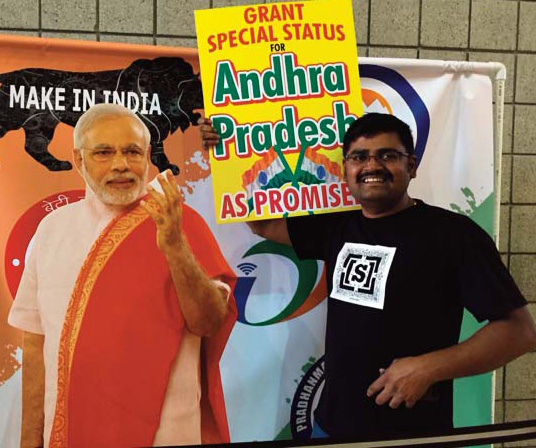
Picture by IndiaParentMagazine
According to Chief Minister of Delhi Arvind Kejriwal, digital development without ensuring basic amenities to all may even lead to human rights violation. For instance on September 28, he tweeted, “[The] Chinese first built China and then corporate giants vied to invest in China. So lets make India first.” He asserts that health and education should be India’s first priority. Once these institutions are developed, India won’t need to seek the help of other countries and their investments. “Instead,” he tweeted, “they will come to us.”
Today, after 16 months of BJP rule in India, there remains borderline alienation in Kashmir, widespread unrest in Punjab, Dalit (lower-caste groups) killings in Haryana and Uttar Pradesh, meat bans all over BJP-ruled states, and lynchings of Muslims in several areas. As intolerance is spreading through the country amongst writers, activists, and civilians alike, the government has simply painted the public anguish as conspiracies against Modi. The number and scope of humans rights violations seem to be unnerving all sectors of society in a way that the country is not used to.
Does development happen in a Vacuum?
Many Indians who voted for Modi in 2014 did so for two reasons, according to Hansen: first, they were tired of the corrupt ruling party, Congress and, two, they were moved by the Modi’s literal and metaphorical cry for development. For the younger voting-age generations, the 2002 Gujarat riots under Modi’s tenure as chief minister of the state may seem like a distant memory, an aberration in history in a remote place. Or perhaps, his much trumpeted and advertised Gujarat Development Model made them willing to give Modi and his plead for development a second chance.
But it soon became apparent that when Modi said development, he meant development only for the upper tiers of society, but a continuation of human rights violation at the base.
“What amazes me is that this party [was] voted in on the mantra of development,” says Romila Thapar, distinguished Indian historian. “Even today they all shout development without defining what they mean.”
DEVELOPMENT AND BUDGET ALLOCATION
Observers in India became suspicious when the BJP government first annual budget actually reduced its health and education allocations. The Union Budget for 2015-16 cut spending on child education, development, health and protection. According to NGO Child Rights and You (CRY), the BJP government’s first annual budget reduced allocations to child welfare from Rs 81,075.26 crore in 2014-15 to Rs 57,918.51 crore this year..
"It is worrisome that the allocation for Integrated Child Development Scheme (ICDS) has declined,” they said in a press release. “On Integrated Child Protection Scheme (ICPS), the allocation increased by only Rs 2.23 crore compared to the previous budget.”
Moreover, one of the most revered medical journals - "The Lancet" - also critiqued Modi for ignoring India's health sector, giving a warning that the nation is on the verge of a collapse from the absence of proper health services, according to a report by the Times of India.
In an interview with the Times of India, Lancet's editor- in-chief Richard Horton said, "since Modi has come in, health has completely vanished. India is on the edge. If [Prime Minister] Modi does not tackle health, India's economy combined with rising population is not sustainable. For India, health is an issue of national security. The government cannot protect the sovereignty of its nation, cannot ensure substantiability unless it has a healthy population. At present Modi has done nothing much to tackle the challenge".
Horton strongly feels that India is on the edge as there are no “new policies, any new ideas, any significant public commitment and most importantly no financial commitment to the health sector,” according to the Times of India.
DEVELOPMENT AND INTERNET BANS
Apart from social and cultural bans, the Internet ban has become a common mechanism to curtail unwanted protests against Hindu rule, such as Eid celebrations in Jammu and Kashmir and Hardik Patel’s revolt in Gujarat (for reservations for upper castes) this past month. Such actions, in addition to the deliberate persecution of NGOs such as Greenpeace, which ensures environmental laws against industrialization and pollution, and activists like Teesta Setalvad, who is fighting for the minorities affected in Gujarat riots, become extremely suffocating to the fabric of Indian democracy, as well as the freedom of speech and action.
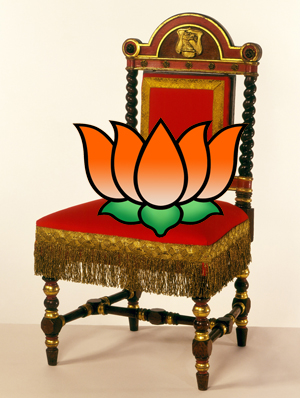
Picture design by IndiaParentMagazine
DEVELOPMENT AND INSTITUTIONAL TAKEOVERS
But arguably the most unsettling new trend under Modi government is the increasing control and occupation of educational, cultural and artistic institutions by RSS and BJP representatives who are not qualified for jobs in said institutions.
Nobel Prize-winning economist Amartya Sen - forced to resign as the Chancellor of Nalanda University, Bihar due to government pressure - insists that the government is methodically transforming major educational and cultural organizations into RSS dens. He claims that "extraordinarily large" interference of the government in academia is throttling and incapacitating progress.
"Nothing in this scale of interference has happened before,” he said. “Every institution where the government has a formal role is being converted into where the government has a substantive role.”
RSS and BJP supporters filled key positions in approximately 14 institutions so far by either forcibly removing those currently in the position, or waiting for department heads to voluntarily resign under political pressure, much like Amartya Sen.
One of the most controversial appointments was that of Gajendra Chauhan as the Film and Television Institute of India (FTII) chairman.The chairman’s post is the organization’s most prestigious one, and was previously occupied by stalwart film directors such as Shyam Benegal and Mrinal Sen. For more than four months, FTII students have been on strike against Chauhan’s appointment, a statement that is denounced by the government. Specifically, the government says the protest is masterfully designed to target and defame the ruling party.
The students also orchestrated a hunger strike against a government they thought refused to listen to them. Tired and beaten after 139 days, the students forfeited the strike in October; at that moment, 11 filmmakers took their burden upon themselves and returned their National Awards in protest.
Other institutes infiltrated with BJP/RSS members include the Indian Institute of Advanced Studies (IIAS), Shimla, Indian Institute of Technology (IIT), Indian Institutes of Management (IIM), National Council for Educational Research and Training (NCERT), Banaras Hindu University (BHU), Tata Institute of Fundamental Research (TIFR), Indian Council of Historical Research (ICHR), Indian Council of Cultural Relations (ICCR), National Book Trust, Indira Gandhi National Centre for the Arts (IGNCA), National Institute of Technology of Nagpur, and the Censor Board of Film Certificate (CBFC) in Prasar Bharti.
According to dissenters such as FTII students throughout India, people appointed by the BJP in these institutions have only one qualification for obtaining the position: being Modi followers. For instance, Lokesh Chandra appointed to head the Indian Council of Cultural Relations is an 87-year-old RSS pracharak (proponent) who claims that Modi is a greater leader than Mahatma Gandhi, and "an incarnation of God.”
Other public figures are also protesting the invasion of BJP members in prestigious educational, cultural, and artistic institutes alongside FTII students. Recently, about 75 sociologists from universities like JNU, the University of Hyderabad, and the University of Delhi, for the first time published a statement criticizing the government’s response to incidents of violence and intolerance (like in the Dadri lynching and the murder of scholars). Their statement read thus which was published in The Wire:
“In a country with some 4693 communities and over 415 living languages, each community is bound to have its own customs. Any attempt to impose a uniform belief or practice, on either individuals or communities, is antithetical to the freedom enshrined in the Constitution. It is the state’s responsibility to ensure this freedom.”
The government’s office is yet to respond to any of these protests. Nevertheless, India will fight back, says Hansen. “India will not allow itself to turn into a Hindu Rashtra. It will stand true to its pluralistic traditions. I truly believe in the people of India and in its strength,” he said.
DEVELOPMENT AND SOCIAL JUSTICE
Recently, BJP leaders were caught promoting the Love Jihad, a movement claiming to protect Hindu girls from marrying Muslim boys.
A recent Cobrapost exposé conclusively established how RSS outfits that perpetrate such violence are well aware that ”Love Jihad is based on a foundational lie. In fact, not a single Hindu woman asked for help, and were blackmailed or forced into filing cases against their Muslim spouses.”
A recent Cobrapost exposé conclusively established how RSS outfits that perpetrate such violence are well aware that ”Love Jihad is based on a foundational lie. In fact, not a single Hindu woman asked for help, and were blackmailed or forced into filing cases against their Muslim spouses.”
"The RSS and the Sangh Parivar have formed a winning strategy of equating Hindu women with everything pious, making them a vessel to forward the Hindu movement," he said in an interview with Outlook.
In addition to the Love Jihad , a new polarizing tactic has emerged: the infamous Beef Ban, disallowing citizens from eating cow meat, since cow is considered the “mother” of the Hindu community.
“A slow fire is kept smoldering and things are brought to boil every now and then to achieve political ends,” said Romila Thapar. “Campaigns like ghar wapsi (forcible conversions of non-Hindus to Hindus), the Love jihad, church attacks, and Beti bachao-bahu lao (“save a girl, bring a wife,” a movement that encourages young Hindu men to marry non- Hindu girls and subsequently increase the Hindu population), the Pink Revolution (initiated by Modi in 2014 to protect cows), and the beef ban are all used to add grist to the mill of religious hate.”
For example, take the case of beef. It is connected to a vast industry involving exporters, butchers, or even leather makers. Thus, the banning of beef also means economic repercussions towards certain targeted sectors of society such as Muslims and dalits (low caste Hindus).
THE GUJARAT RIOTS, 2002 AND HINDUTVA
Hansen explains that a secular society and polity does not exclude religion. Rather, it suggests that the religious identity of anyone is secondary to their primary identity as a citizen, and that the the state has to guarantee the rights that come with this identity as the rights of citizenship, not based on religion.
As Modi prepared for his international US promotion of “Digital India” and “Make in India,” 76-year-old Zakia Jafri, wife of the late Congress Member Ehsan Jafri, initiated a legal battle with the help of activist Teesta Setalvad. Specifically, she was charging the Prime Minister for the death of her husband in the 2002 Gujarat riots (according to the Wall Street Journal).
Ehsan Jafri was butchered and burned alive during the riots for housing Muslims. Though he made multiple phone calls for help to authority figures like the then-Gujarat-chiefminister Modi, nobody came (according to his wife). Instead, Jafri was chopped into pieces and burned alive (in violent riots, Muslims are burned as such a practice is against their Islamic religion; normally, they are buried after death). And he was not alone; the RSS and fellow Hindu fringe group Bajrang Dal terrorized 2000 others in retaliation for the death of 45 Hindus burned in a train in Godhra. One police officer even testified that Modi gave free reign to these groups, who is removed from his post and till today is being hunted by the BJP government.
Now, 13 years later, Jafri is still looking for justice. This is the last case amongst many against Modi which might still prove his guilt. All others are closed since then for lack of evidence. Jafri is not just fighting for her murdered husband, but also for the thousands of other men, women and children who have been raped, tortured and set on fire during the Gujarat riots, most of whom were Muslims, according the report in Wall Street Journal.
Many scholars like Hansen believe that the Gujarat riots were a form of ethnic cleansing by the Hindutva groups and its other wings, and that in many ways was premeditated, and carried out with full complicity of the state government and officers of the law. Hansen also sees it as a cleansing effort of self by the RSS.
“The founder of RSS really saw itself as a Hindu vigilante group,” Hansen said. “He felt that Hindus became weak because they have accepted their own subjugation at the hands of Muslims over centuries. The whole movement is about restoring a certain pride in Hindu masculinity and in Hindu warrior values.”
He elaborates that the physical and psychological training RSS enforces instills this prejudice against Muslims. “The idea of strengthening the mind by strengthening the body against Muslims, it’s all about in a sense driving the fear of Muslims out of your mind by fighting them on the streets.”
And the Gujarat riots, one of its worst in the history of independent India showcased the violent side of Hinduism called Hindutva. The term Hindutva was first coined in the late 1800’s by Hindu nationalists which in the modern era has come to exclusively describe fringe Hindu religious fanatics and chauvinists groups like Shiv Sena and Bajrang Dal. Not all Hindus adopt Hindutva. The pogrom of Gujarat killed 2000 people, destroyed centuries of historical documents and mosques and orphaned hundreds of thousands of people.
“The fact is,” says Hansen wistfully, “there is no value to a Muslim life in India today.”
During his tenure as chief minister of Gujarat after 2002, Modi’s relationship with many Western nations became troubled, as questions about his role in the 2002 riots arose. This resulted in travel bans to the UK, the U.S. and the EU. Nine years ago, U.S. officials denied Modi a visa just as he was preparing to travel to New York to address Indian-Americans at a rally scheduled in Madison Square Garden. According to the Wall Street Journal , Modi’s inability to halt the Gujarat riots constituted a “severe violation of religious freedom,” that, as per to the State Department’s little-known 1998 law, made the current prime minister ineligible for a visa. Modi is the only person ever who was not granted a visa for this reason.
“Modi’s Hindutva idealism, strengthened and sharpened by the RSS, can never be underestimated,” emphasized Hansen. In the tug of war between true national development and a potentially infectious, belligerent cultural agenda, Modi seems to lean toward the latter, he said. “We have to understand the man instead of thinking of him as some kind of savior who’s come out of nowhere and conceived all these ideas of Digital India , ” he said. “None of what he stands for is his own thinking, he is entirely shaped by the RSS movement.”
Hansen says that Indira Gandhi was not virtuous by any measure but her disingenuity could never equal that of Narendra Modi.
According to one historian and political analyst who signed the petition (and chose to remain anonymous), Modi, by mixing the development myth with well-calibrated communal rhetoric, has created a class of devotees who are not only happy to crawl but even dance with delirium. And he could do all this and more without actually declaring the Emergency!
When you push an entire community to a corner and force a culture that is not viable to them, there is bound to be a revolt of some sort, Hansen said. “And Modi both symbolically with his silence and strategically through action via various fringe groups such as RSS, VHP, and Sanathan Dharma Sanstha, is promoting a culture that is both historically confused and polarizing.”
Many historians believe that the RSS hatred for Muslims is based on a fundamentally wrong understanding of history. Dr. Audrey Truschke, Mellon Postdoctoral Fellow at Department of Religious Studies at Stanford University, explained that the BJP advances a vision of Indian history which glorifies Hindu past. Specifically, it paints a picture where Hinduism was supposedly disrupted by foreign Islamic rule, and as a result ought to be reinstated. Her research upsets a key component of this storyline by showing that the Mughals, an Islamic dynasty, supported Sanskrit literary production like so many Hindu kings before them; this indicates a past of cooperation and conversation between religious groups rather than communal conflict, as the RSS have been promoting.
“Modi has managed to bury the past and resurrect his own extinct prospects for political advancement, replacing epithets like ‘fascist,’ ‘mass murderer’ and ‘ Hindutva fanatic’ with a title of his own choosing: Vikaas Purush , or Development Man,’” writes Vinod K. Jose in Caravan. “‘For the first families of Indian business, Modi is ‘the next leader of India,’ ‘a visionary,’ ‘the unstoppable horse,’ and ‘the CEO who can lead the country,’ to quote just a sampling of the effusive endorsements from men named Tata, Ambani and Mittal.’”
However, within the past 16 months of BJP rule, various bans on individual states have become the norm. Omar Abdullah, Member of the Legislative Assembly, Jammu and Kashmir, tweeted sarcastically during a statewide ban on Internet and phone usage during Eid festivities, “‘Oh, the irony of listening to the [Prime Minister] talking about Digital India while we in J&K (Jammu and Kashmir) spent three days totally disconnected due to his party & allies.’” The ban occurred thrice on separate occasions while Modi promoted Digital India in the U.S., and, as some argue, prove that “net neutrality” and “net freedom” also remain major issues in the nation.
Many Modi critics like Falk and Hansen contend that the Prime Minister’s development model is paradoxical. While Modi advocates digital power, he simultaneously attempts to restrain freedoms via various bans, including those on the Internet, that have infringed on individual privacy. Likewise, Modi talks of female sacrifice and participation, but precludes women’s freedom. Though NRI’s may be satisfied with his equivocation, minorities, women and Dalits in India must bear the brunt of his ambiguous, vague intentions.
THE GUJARAT MODEL OF DEVELOPMENT
The flaunted Gujarat model is more a fantastical vision rather than reality, says Hansen.
“Workforce comes from outside,” he said. “Gujarat does not have a great record on mass employment. It looks developed because of some industries such as TATA motors. A lot of it has to do with aesthetic makeover: create roads, glass and steel facades, etc. It looks modern but I don’t think that structural problems are addressed as there are no MITs or engineering or art colleges.”
The Planning Commission’s data, show that in spite of Gujarat’s economic growth, the state lags behind even Bihar, Uttar Pradesh, West Bengal and Andhra Pradesh in rates of poverty reduction. According to the 2011 India Human Development Report, Gujarat also scores poorly in several social indicators, with 44 percent of children under five suffering from malnutrition, worse than Uttar Pradesh. And the biggest proof of failure of Gujarat model came in the form of Hardik Patel, a young rebel, who, despite belonging to the richest caste in Gujarat, went on a protest against Modi’s development model, demanding reservations. His movement received unparalleled support from the masses and shook BJP support base in Gujarat. Patel’s basic protest point is that there are no enough jobs in Gujarat and hence even the Patel community needs reservation.
“There is a certain kind of middle class narcissism involved in [the Gujarat model], ... but poor people can’t really relate to that,” Hansen said. “Unfortunately, the successful people of Indian origin in the technology sector globally fuelled that particular kind of perception that ‘we are the real citizens of India’ rather than those poor fellows. They forget these poor fellows have vote too.”
Despite the fantastic model flaunted by Modi, Gujarat ranks 13th amongst 29 other states in India for poverty and 21st in education. Nearly 45 percent of children under five are underweight and 23 percent are undernourished, putting the state in the "alarming" category on the India State Hunger Index. And Modi rubbishes it off by saying that young girls don’t eat enough because they are weight conscious.
Individually, these statistics are not sufficient to nail Modi. However, they do imply that he has a well-designed image in the public eye as an economic mastermind, due to smart public campaigning in which he has shown Gujarat as the forefront of development, and labels anyone who presents data to question actual progress of his plan as having a twisted personal agenda.
The Acid Test to Modi’s Charisma
On September 27, facing the 18,000 adoring American Indians in the SAP center, San Jose, the Indian Prime Minister roared thunderously, “Here, I am standing in front of you. Do you have anything to ask of me? Do you have any doubts?” The crowd cheered and chanted his name.
But, unfortunately for Modi, Silicon Valley is not his electorate, nor is he running for a governor post in California. It is the 1.25 billion people of India to whom he must ask these questions. And they are watching and waiting for their Prime Minister to resolve countless disconcerting, pressing issues. According to 75 sociologists expressing such concern in a letter to the Prime Minister, “A country with 4693 communities and over 415 living languages feels threatened and violated by Modi’s impingement on their freedom, from their quotidian existence to their religious beliefs,”
They want Modi to ensure strict action against detractors, and that he will reject the RSS ideology he has nourished since childhood.
Yet all that Modi has left for his people is silence. A silence that, according to the Indian journalist, author and politician Arun Shourie, is “deliberate.”
“The intellectual protest is the Gandhian thing to do,” he said in an interview with India Today. “It’s a peaceful non- cooperation movement. When 400 writers, artists, historians, filmmakers, scientists and sociologists protest (against violation of fundamental rights) and the head of the state is silent, it’s as if he is saying in Mussolini’s words, me ne frego - I don’t give a damn.”
Ultimately, whether or not Modi's autocratic power can keep clenching onto India, and whether or not the pen proves mightier than the sword, only the Indian electorate can decide.
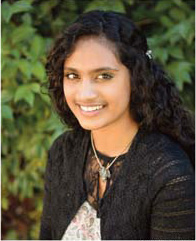
About the writer
Sindhu Ravuri, freshman, UC Berkeley is an award winning writer and journalist. She recently won UC Berkeley's Alpha Delta Phi Literary Scholarship (1st place), and CAA Leadership Award as well. Her article on college online dating won Gold Key Award (Scholastic) 2015. In 2013 she won Merida Award at the San Jose Mercury News Mosaic Internship. As a senior at the Harker School she founded Wingspan Magazine and worked as its Editor-in-Chief.
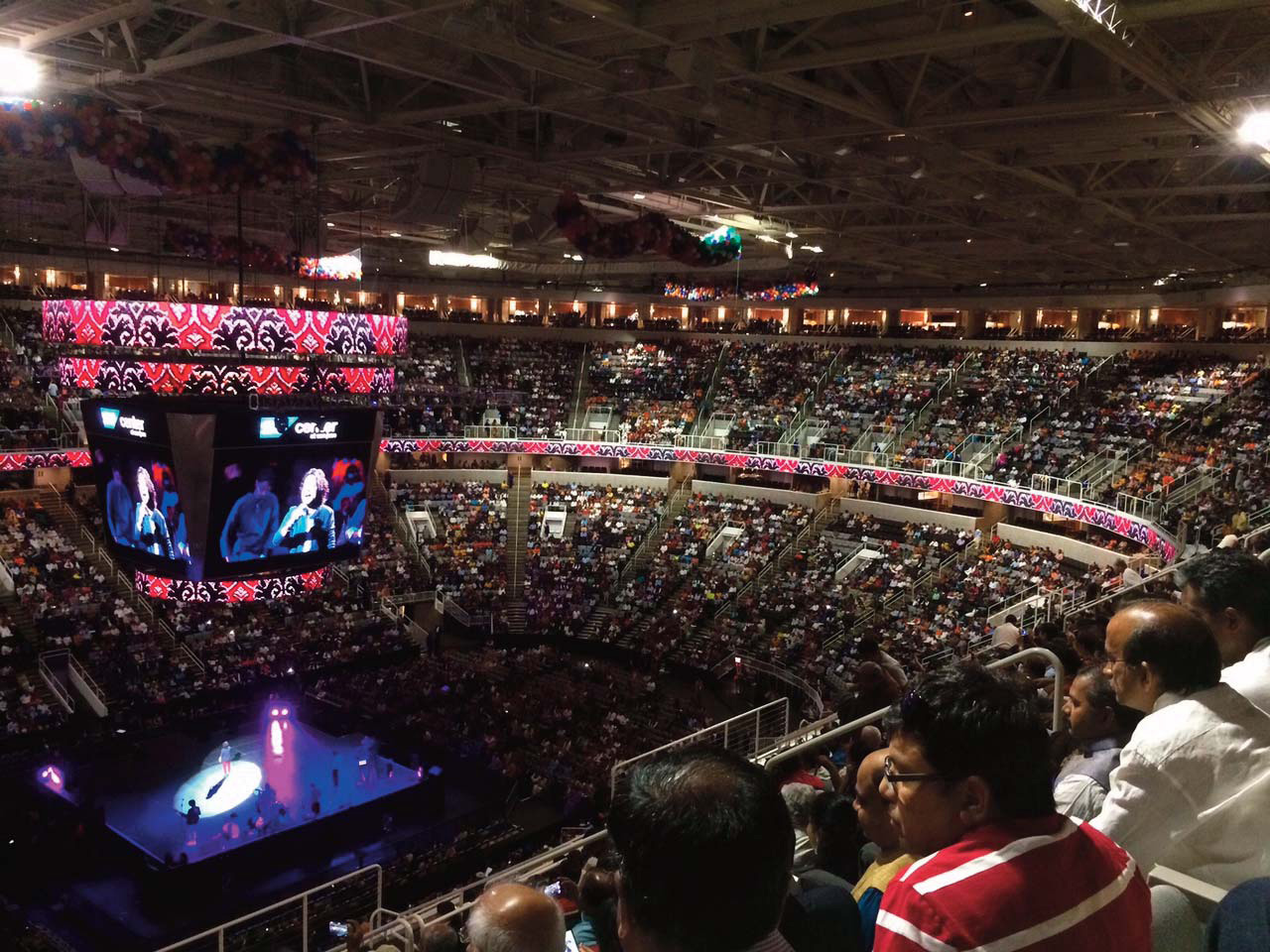
Modiʼs speech at the SAP center
Picture by IndiaParentMagazine

 1.408.254.0954
1.408.254.0954




